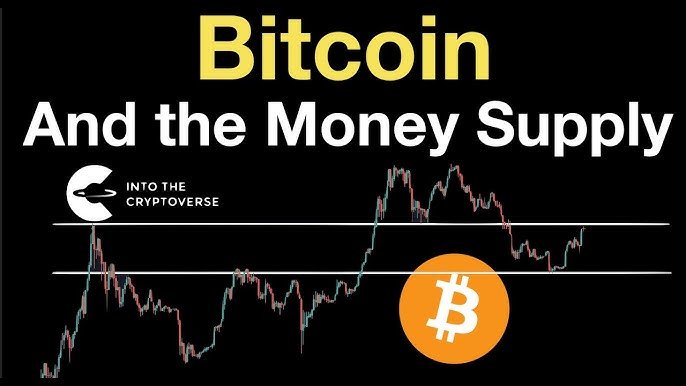Bitcoin, the leading cryptocurrency by market capitalization, is no stranger to volatility. As we approach 2024, financial analysts are closely examining macroeconomic indicators to predict its price trajectory. One key factor under scrutiny is the M2 money supply—a measure of the total amount of money available in an economy, including cash, checking deposits, and easily convertible near money. Analysts warn that if the M2 money supply remains steady or contracts, Bitcoin could face a significant price correction of up to 20%.
What M2 Money Supply Means for Bitcoin
To measure the system’s liquidity, one must look no farther than the M2 money supply. In general, risk assets like Bitcoin benefit from an accommodating monetary policy, which is generally signaled by an increase in the supply. In contrast, if the M2 supply is stable or falling, it could mean that monetary conditions are tightening and fewer people are willing to put their money into risky assets.
There has been a correlation between liquidity trends and Bitcoin’s price history. Substantial bull runs in Bitcoin have occurred during times of QE, when central banks inject liquidity into the economy. For example, in late 2021, when central banks around the world injected record amounts of liquidity, the cryptocurrency hit an all-time high.
The focus shifted to tighter monetary policy in 2023 as central banks battled inflation. Consequently, the expansion of the M2 money supply came to a halt. This tendency may continue into 2024, according to analysts, which might make Bitcoin’s price stability a struggle.
Bitcoin Could Fall 20%
- Reduced Liquidity and Risk Appetite
A steady M2 money supply implies limited new liquidity entering the financial system. This scenario often leads to reduced risk appetite among investors. Bitcoin, being a highly speculative asset, is likely to see diminished demand under such conditions. - Correlation with Broader Market Trends
Bitcoin has increasingly mirrored movements in equity markets, particularly technology stocks. If liquidity remains constrained, broader market indices may also struggle, dragging Bitcoin along with them. - Institutional Participation and Macro Sensitivity
Over the years, institutional investors have become significant players in the Bitcoin market. These investors are highly sensitive to macroeconomic factors like liquidity, interest rates, and money supply. A static M2 money supply could deter institutional inflows, amplifying downward pressure on Bitcoin’s price.
A Year of Uncertainty for Bitcoin
In 2024, macroeconomic concerns must be recognized, and a 20% fall is concerning. The Federal Reserve and other central banks may loosen policy if economic growth or inflation slow. This shift could revive Bitcoin by increasing liquidity and investor excitement.Bitcoin remains valuable as a decentralized asset and insurance against fiat currency decline. A cryptocurrency’s durability is strengthened when long-term holders see corrections as buying opportunities, even as short-term investors face headwinds.

The Role of Halving in 2024
Another factor to consider is Bitcoin’s halving event, expected in 2024. This built-in mechanism reduces the reward for mining Bitcoin by half approximately every four years, effectively decreasing its supply. Historically, halving events have preceded major price rallies due to reduced sell-side pressure and heightened scarcity narratives . While the halving could counteract some of the negative effects of a steady M2 money supply, its impact might be delayed or muted if macroeconomic conditions remain unfavorable.
Analyst Recommendations
Market analysts advise caution for investors in 2024. Diversification and risk management will be essential for navigating Bitcoin’s potential volatility. Some recommend focusing on dollar-cost averaging strategies to mitigate the impact of price fluctuations. Others suggest closely monitoring macroeconomic indicators, including central bank policies and M2 supply trends, to anticipate market shifts.
Trump’s policies may strengthen the dollar
On the other hand, there are many who are concerned that the impending tariffs imposed by President-elect Trump on imported goods will only serve to strengthen the US dollar, which has a track record of undermining riskier assets such as Bitcoin. In a Bloomberg article published on November 5th, hedge fund manager Scott Bessent noted that “Tariffs cause a stronger dollar.”It is an economic anomaly for the dollar to weaken in the face of tariffs. Bitcoin is trading at $91,988 as of this writing, only days after coming dangerously close to the much anticipated $100,000 mark. On November 23rd, Bitcoin hit an all-time high of $99,571.
Read More : Bitcoin Prodigy? Kiyosaki Backs Saylor’s Risky Move
Conclusion
The M2 money supply is one of many macroeconomic variables that will determine Bitcoin’s price path in 2024. A 20% correction is possible for the cryptocurrency if liquidity stays tight and the M2 supply stays stable. These obstacles may, however, be mitigated by other processes, such as the halving of Bitcoin or changes in central bank policy.
To make educated judgments in the new year, investors must grasp the bigger picture of the economy and keep up with important indicators. Bitcoin has a history of resilience, so even though the future is unknown, it will adapt and evolve, keeping itself at the center of the financial world.
[sp_easyaccordion id=”2821″]









